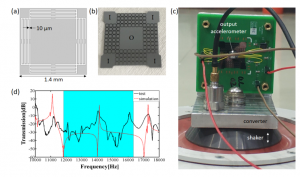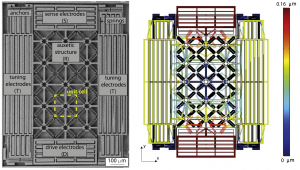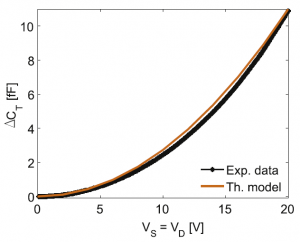Close
MetaMEMS
A metaplate in MEMS for innovative applications: vibration isolation and tunable mechanical filters
This work is carried out in collaboration with the Nanjing University of Science and Technology, Nanjing, China
People involved: V. Zega, Z. Yao, Y. Su, A. Corigliano
A new metamaterial plate (metaplate) composed of innovative phononic crystal unit-cells is presented, numerically studied, fabricated at the microscale and experimentally tested. Numerical simulations and experimental tests demonstrate a complete 3D phononic bandgap that guarantees a complete vibration isolation in a certain range of frequency. Moreover, its compatibility with Micro Electro Mechanical Systems (MEMS) fabrication processes suggests applications for vibration isolation of MEMS resonant devices. The measured transmission diagram shows a -30 dB attenuation level, which is in good agreement with numerical predictions. The proposed design opens up new perspectives for the development of vibration isolation applications for MEMS resonators.

Figure 1: (a) Schematic view of the unit cell of the MEMS metaplate working as a vibration isolation platform for MEMS resonant devices. (b) Fabricated
MEMS metaplate. (c) Experimental set-up. (d) Comparison between experimental and numerical transmission diagrams.
The proposed metaplate is employed in MicroElectroMechanical Systems (MEMS) to achieve vibration isolation of resonant devices (Figure 2a) and to design a mechanical tunable filter (Figure 2b), thus opening the way to a new class of metaMEMS that can strongly improve the performances of actual MEMS devices or even provide a valid alternative to the actual state of the art.

Figure 2: Schematic view of the metaplate working as (a) vibration isolator and (b) tunable filter.
Bibliography:
[1] Z. Yao, V. Zega, Y. Su, A. Corigliano, ‘A metaplate in MEMS for innovative applications: vibration isolation and tunable mechanical filters’ IEEE SENSORS 2020, online conference, October 25-28, 2020.
[2] Z. Yao, V. Zega, Y. Su, J. Ren, J. Zhang, A. Corigliano ‘Design, fabrication and experimental validation of a metaplate for vibration isolation in MEMS’ J. Microelectromech. Syst., 29(5), (2020), 1401-1410.
[Patent] Z. Yao, V. Zega, Y. Su, J. Zhang, A. Corigliano ‘Dispositivo MEMS con piastra d’isolamento vibrazioni’ Deposited patent 102020000012943 (May 2020)
Short summary of the activty
Summary of the work presented at IEEE SENSORS 2020 conference
subject to IEEE copyright
MEMS Auxetic structure
People involved: V. Zega, A. Nastro, R. Ardito, M. Ferrari, V. Ferrari, A. Corigliano
An innovative auxetic unit cell is presented, numerically studied, fabricated at the microscale and experimentally tested. Its versatility in terms of stiffness and Poisson’s ratio and its compatibility with commercial Micro Electro-Mechanical Systems (MEMS) fabrication processes suggest applications such as motion conversion and amplification mechanism in MEMS devices or on-chip biaxial tests.
A MEMS auxetic and periodic structure exhibiting an overall equivalent Poisson’s ratio lower than -1 is then proposed and fabricated.
The static and dynamic behaviours are studied both numerically and through a simplified analytical model.
Experimental results confirm the simulated behaviour of the structure thus verifying the first MEMS auxetic structure with electrostatic actuation and capacitive readout.

Figure 1: Scanning electron microscope (SEM) image of the fabricated auxetic structure. (b) Auxetic behaviour of the structure: a displacement of ±0.1 μm has been applied on the right and left tuning electrodes, respectively.

Figure 2: Capacitance variation measured on the tuning electrodes versus voltage applied on sense and drive electrodes.
Bibliography:
[1] V. Zega, A. Nastro, M. Ferrari, R. Ardito, V. Ferrari, A. Corigliano ‘Design, fabrication and experimental validation of a MEMS periodic auxetic structure’ Smart Mater. Struct. 28 (2019) 095011.
